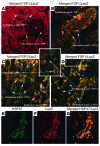Epithelial-mesenchymal transition (EMT) in kidney fibrosis: fact or fantasy?
- PMID: 21370523
- PMCID: PMC3026733
- DOI: 10.1172/jci44595
Epithelial-mesenchymal transition (EMT) in kidney fibrosis: fact or fantasy?
Abstract
Epithelial-mesenchymal transition (EMT) has become widely accepted as a mechanism by which injured renal tubular cells transform into mesenchymal cells that contribute to the development of fibrosis in chronic renal failure. However, an increasing number of studies raise doubts about the existence of this process in vivo. Herein, we review and summarize both sides of this debate, but it is our view that unequivocal evidence supporting EMT as an in vivo process in kidney fibrosis is lacking.
Figures





References
-
- Thompson E, Newgreen D. Carcinoma invasion and metastasis: a role for epithelial-mesenchymal transition? Cancer Res. 2005;65(14):5991–5995. - PubMed
Publication types
MeSH terms
Substances
LinkOut - more resources
Full Text Sources
Other Literature Sources
Medical

